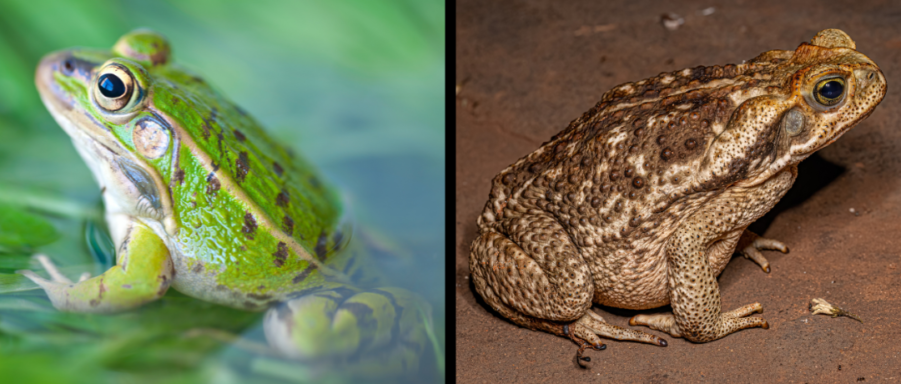Frogs and toads are exciting animals to come across in the wild. Although widespread, they can be hard to find, but are cute and entertaining for nature lovers of all ages. I love coming across these critters on nature walks for the many fascinating natural history stories they bring to mind. When we get so lucky, the first words out of people’s mouths are, “is that a toad or a frog?”. This makes telling the difference between toads vs. frogs a handy naturalist skill. Furthermore, as you might have guessed, it’s more complicated than it might seem.
Unfortunately, most guides on other blogs and webpages tend to confuse or oversimplify the situation, or have information that’s just plain wrong. So let’s set the record straight! In this Naturalist Answers post, let’s learn the differences between frogs vs. toads and how to tell them apart.
What’s the difference between butterflies and moths?
Frogs vs. toads: What’s what
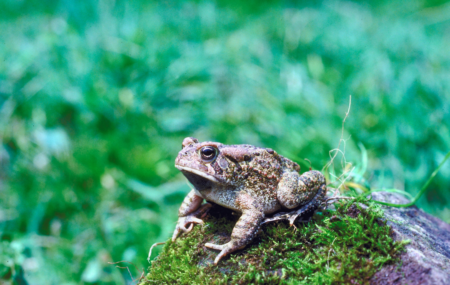
One of the most important and surprising things to know about frogs and toads is that they are a lot like rectangles and squares. Not in shape, of course, but conceptually. Have you ever heard someone say that all squares are rectangles, but not all rectangles are squares? This is because rectangles include all shapes with four sides, but squares have to have four sides and all four sides have to be equal in length. This means that squares are a subset of rectangles.
Why are we talking about squares and rectangles? Because it helps to illustrate a similar point: all toads are frogs, but not all frogs are toads. Toads are a subset of frogs! Frogs and toads are amphibians, belonging to the class Amphibia. These fantastic, water-breeding animals were the first vertebrate animals on land and maintain many ancient characteristics. Among the amphibia, frogs and toads belong to a group called the Anura meaning “without a tail”. Indeed, with very few exceptions, frogs and toads are tail-less beasties as adults.
What do words like Class, Order, and Family Mean? Check out this Post!
How frogs and toads are classified
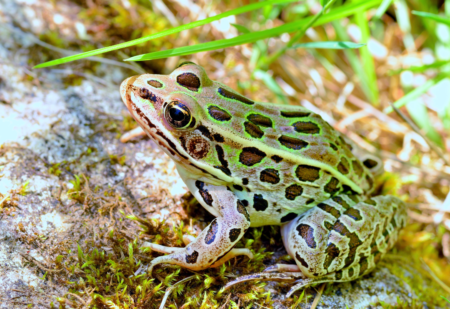
Scientists and naturalists refer to all animals in the order Anura as frogs. However, the common name of “toad” refers to a smattering of other species. Many of these species are not related to one another, since people gave them their common name “toad” before scientists had studied the relationships between these organisms.
Of the more than 6,200 described species of frogs (Anurans), somewhere around 300 belong to a family called the Bufonidae. Nature experts refer to members of this family as “true toads”, and they are probably the best example of what folks normally call “toads” in everyday life. However, there are other groups of frogs that also have “toad” in their common names, like:
- Spadefoot toads (Scaphiopodidae and Pelobatidae families)
- Austral spadefoot toads (genus Notaden, and its cousin the bizarre moaning frog Heleiporus eyrei)
- Narrowmouth toads (family Microhylidae, also including the sheepfrogs)
- Midwife toads (Alytidae family)
- Mexican burrowing toads (genus Rhinophrynus)
Learn more about what makes common names tricky and scientific names useful
7 differences between frogs and toads
So, how do you tell the difference between frogs vs. toads? Acknowledging their many similarities and the fact that toads represent many different groups, we can still draw some general guidelines. As with other living things, we can draw clues from their behavior, location, and appearance. If you want to tell a frog from a toad, here are some great places to start:
- Skin. Is it smooth or bumpy? Is it dark or brightly colored? Does it look wet or dry?
- Legs. Are the back legs about the same length as the front? Are they much longer?
- Feet. Are the toes webbed or separate? Are there claws or other parts sticking out?
- Movement or gait. Does it hop, leap, walk, or climb?
- Habitat. Did you find it near the water? Is it sitting in a tree or shrub? Did it come out of a hole? Was it on the ground?
- Voice. Do you hear rhythmic sounds or an ongoing trill?
- Behavior. Was your animal digging? Climbing? Hunting? Swimming?
1. Skin
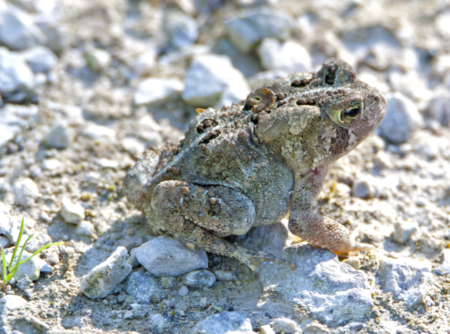
When it comes to telling toads vs. frogs apart, I always start with the skin because it can be the most obvious. In fact, having seen many of the other groups of “toads” outside of the family Bufonidae, I think it is part of how they got their name. Broadly speaking, toads skin is dry to the touch, and not glossy. By contrast, frogs skin typically is smooth, moist, and shiny.
The true toads’ (Bufonidae) skin is bumpy with little “warts” known as granular glands. They also have larger glands behind their eyes called paratoid glands. These produce toxic chemicals as a defense, making toads poisonous if eaten by pets. Other anurans that people call toads typically share the characteristic of bumpier, drier-looking skin even if they don’t have the same glands.
What’s the difference between venomous and poisonous animals?
Toads and frogs may also differ in their skin color. Most toads are relatively dull in color, with a mixture of brown, beige, and ruddy hues. On the other hand, the huge variety of frogs in the world includes some incredibly colorful specimens. In some cases, dangerous toxins in their skin warrant warning coloration, as in the vibrant poison dart frogs. In temperate areas like parts of Europe, Asia, and North America, frogs are more often green or grayish.
What is aposematic coloration and what does it have to do with dangerous animals?
2. Legs and feet
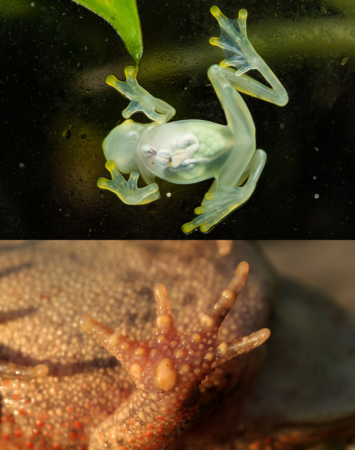
Frogs’ four limbs are a big part of how they do business. Legs help them get around and navigate the habitats that they occupy. Because of this, their characteristics can tell you a lot about the frog and its lifestyle. Since many frogs move by leaping (what scientists call saltatory), they often have long, powerful back legs. Their front legs, or forelegs, may be shorter, creating a disproportionate look. By contrast, the true toads’ four legs are often much more similar in size. Treefrogs like those in the family Hyla often have long, slender legs to help with their tree-dwelling (arboreal) life style. Toads, especially those in the Bufonidae, will have chunky, stubby limbs instead.
Feet are also super important! What do you see on your frog’s toes? Toads will more often have claws for traction or digging. Frogs, being more aquatic, are more likely to have webbing between their toes. Climbing frogs may have adhesive pads at the end of each toe.
3. Movement
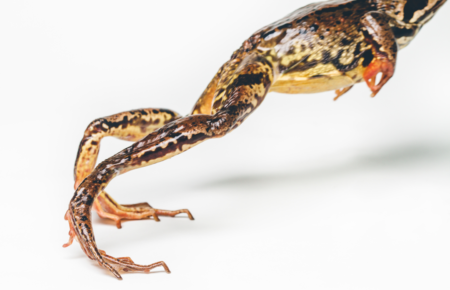
As you might have guessed from all that talk about their different legs and feet, toads also more differently than many other frogs. It’s important to remember, however, that since toads belong to the larger group that is frogs, there will be some non-toads that move like them. Nonetheless, in many parts of the world frogs do more leaping (that is, big jumps!) while toads are hoppers (small jumps). Some toad species are also more prone to walking around the ground.
You’re more likely to come across a toad hop-hop-hopping slowly along the ground, or marching down a path, than a frog. Frogs will more typically remain stationary between longer bounds, and will more often take those leaps trying to escape you.
4. Habitat

The context of where you find many plants and animals can be as good a clue to their identity as anything. This holds true for anurans like frogs and toads. Generally speaking, the true toads or Bufonidae are slightly more independent from water than the rest of the frogs. Although all amphibians, including the Anurans need water to breed, not all of them have to stay near the water for their whole life cycles.
Learn more about how to describe natural places by what you see around you
The true toads and several of the groups known as spadefoot toads can wander further from water than other species of frogs. This is part of why their skin looks so different. Because of this, you’re more likely to come across toads in habitats like:
- Forests further from water
- Meadows
- Grasslands
- Gardens
- Deserts
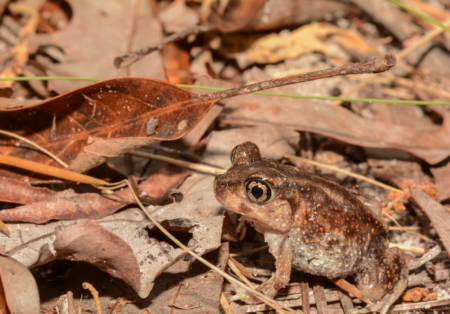
By contrast, other frogs will stick closer to water. You’d expect to more commonly find them near:
- Rivers and streams
- Lakes
- Marshes and swamps
- Vernal pools
Smaller habitat features may also make a big difference. Since non-toad species of frog like treefrogs and glass frogs (Centrolenidae) are the big climbers among Anurans, finding a frog in a tree or shrub can rule out lots of toads. Meanwhile, the true toads and other toads that look like them are bigtime burrowers. Finding a frog in a hole, or near one, means you’re probably looking at a toad of some kind.
Why are wetland habitats important?
5. Voice: how do frogs. vs. toads sound?
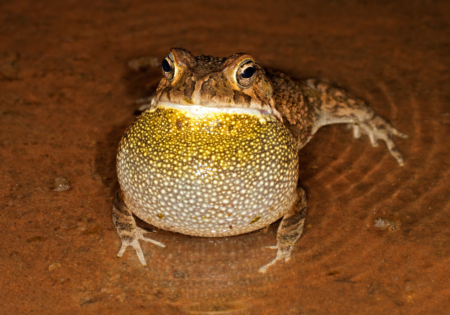
If you’re lucky enough to hear some frogs calling, their voices can also be a great clue. Although voices vary hugely over the thousands of frog species in the world, the true toads are fairly consistent. They tend to “sing” for mates using a long, high-pitched and drawn-out trill. Some of the smaller toads, like oak toads (Anaxyrus quercicus) hve a birdlike chirp of squeak that they give repeatedly.
These toad-specific voices can be easy to tell from other groups of frogs given a little practice. Frogs in the Ranidae family give more typical croaks and ribbits that we associate with frogs, while treefrogs can bark or squark. Frogs often give more rhythmic and complex calls than toads.
Keep in mind that you can also use vocalizations to find frogs, or at least their approximate locations. Is the sound coming from a tree? If so, it’s more likely to be a frog. Is it coming from inside of a hole? Or a dry part of the forest? I might bet a toad, instead.
6. Eggs
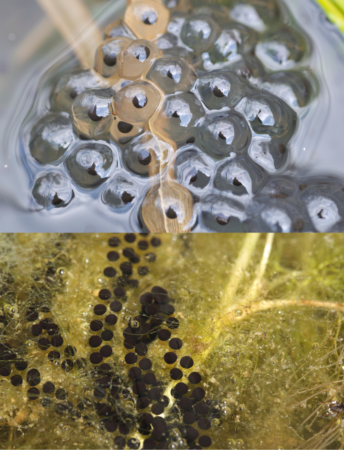
Toads also differ from other frog species in the way that they lay their eggs. Of course, you’d need to be in the right place at the right time to find amphibian eggs, so this isn’t necessarily the most reliable clue. However, if you come across what look like toad or frog eggs, you might be able to pick up on some details. True toads lay their eggs in strings, and these typically sit below the water’s surface, often fully submerged. They look like a clear necklace strung with tiny black dots.
Other groups of frogs lay their eggs in a wide variety of different configurations. However, most of the pond-breeding frogs, especially in temperate areas, are fairly consistent. They lay larger eggs in a clump or mass in the water. They typically attach this to aquatic vegetation or another object in the water column. Frog egg masses may be closer to the surface or in contact with it.
7. Behavior
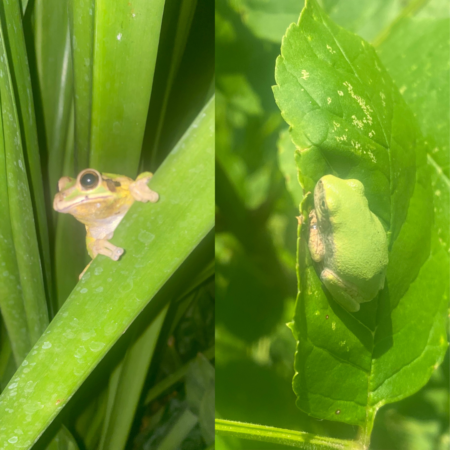
One of the most important cues for any naturalist identifying wildlife is behavior. Put simply, what is the animal doing? If you find a frog swimming or sitting in the water, it might be more likely to be a frog than one of the true toads. Since the latter are more terrestrial, they’ll only really be spending a lot of time in the water during the breeding season. If you don’t see eggs around and your amphibian is happily sitting in the water, it may more likely be some other kind of frog.
Any digging behavior is much more characteristic of toads, while climbing is more common in various species of frog. How these animals respond to your presence may also give some clues. I have also noticed that frogs may stay stock-still and try to hide when I approach, only to spring away in a sudden leap. On the other hand, toads seem to just get straight to hopping when they hear me coming!
Thanks for reading!
If you enjoyed this post, please support the blog by sharing this post with friends. Follow Gulo in Nature on social media to get the latest from the blog. If you’ve got more nature related questions or content you’d like to see on the blog, get in touch using the Contact Page. We’d love to hear from you!

